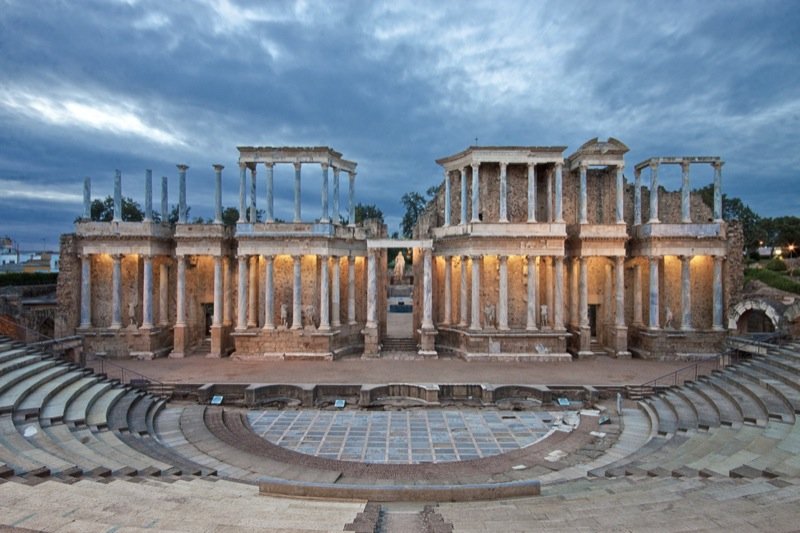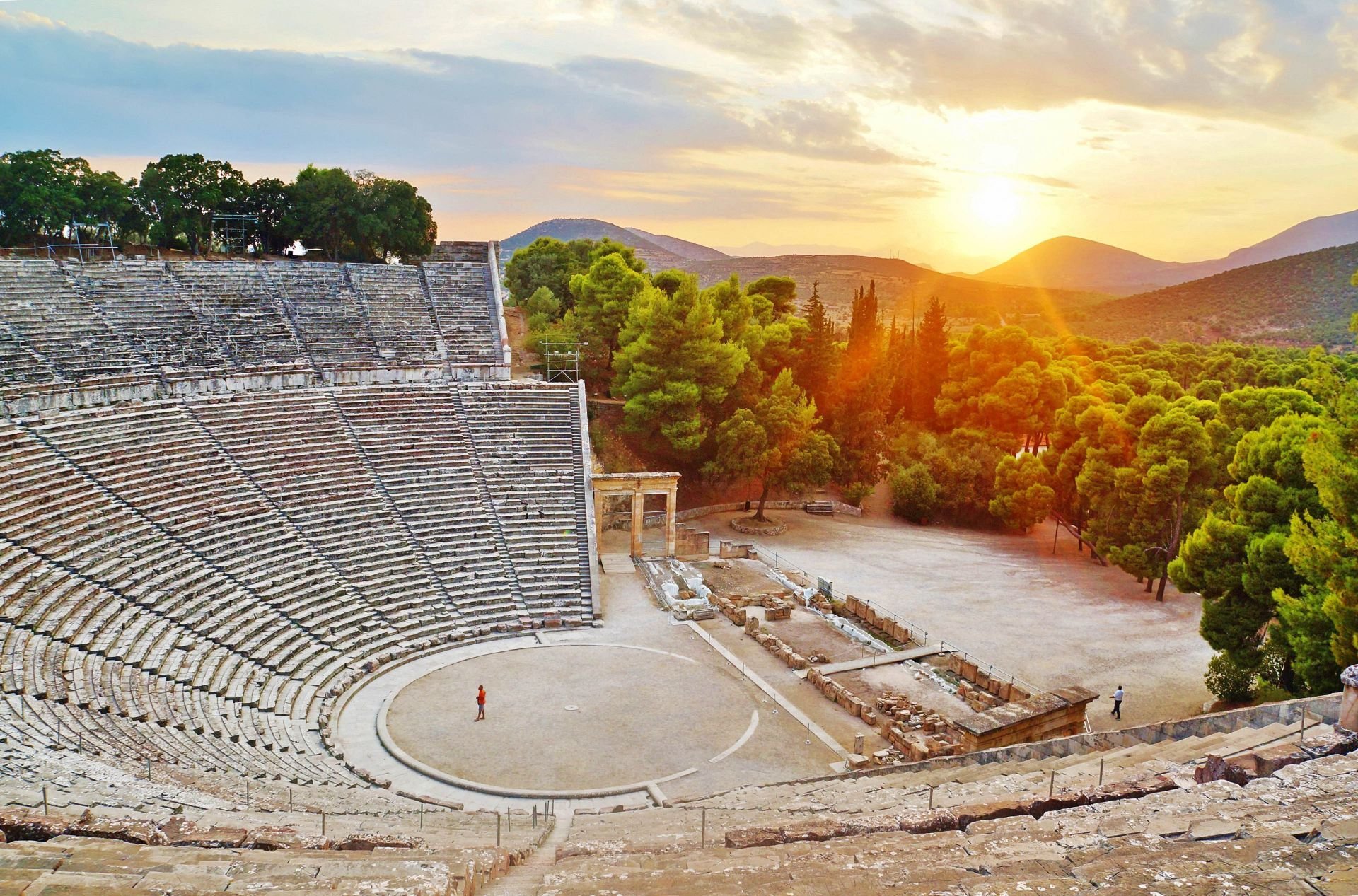Scattered around the Mediterranean lie the remains of the ancient theaters of the Greek and Roman world. The Greek theaters were large, open-air structures constructed on the slope of a hill. Roman theaters, although heavily influenced by the Greeks, have specific differences, such as being built upon their own foundations.
The theater originates from the city-state of Athens where it was used for festivals honoring the god Dionysus and the famous Athenian tragedy, comedy, and satyr plays. The Romans, being a little bit less philosophical in spirit than the Greek, wanted more pure entertainment with lots of laughs and excitement. Popular entertainments in Roman times included mime plays, acrobatics, jugglers, animal fights and gladiator fights although the later two were more common in the Roman amphitheater.
14. Theater of Taormina
Taormina was a Greek colony on the east coast of the island of Sicily. The theater of Taormina was built by the Greeks in the 2nd century BC and restructured and widened by the Romans. The ancient theatre is beautiful situated, overlooking the bay of Naxos and mount Etna. Today it is the center of the Taormina’s international film festival.
13. Jerash Theatres
Jerash is a popular archaeological site in Jordan, second only to Petra. The city’s golden age came under Roman rule and the site is now generally acknowledged as one of the best preserved Roman provincial towns in the world. Jerash contains not one but two Roman theatres. The north theatre, with a capacity of 1600, was built in 165 AD and was mainly used as the city council chamber. The larger south theatre was built between 90-92 AD and could seat more than 3000 spectators.
12. Odeon of Herodes Atticus
The Odeon of Herodes Atticus, cut into the southern slope of the Athenian Acropolis, was built in 161 AD by Herodes Atticus in memory of his wife. The structure was used as a theatre in ancient Athens for various plays and music concerts. It originally had a wooden roof and could seat up to 5,000 people.
11. Roman Theatre of Merida
According to an inscription, the Roman Theatre of Merida in present-day Spain was built in 16 BC by order of Agrippa, a general and friend of emperor Augustus. The ancient theatre could house up to 6,000 spectators. In later centuries the theater underwent several restorations which introduced new architectonic elements and decorations. The structure was restored to the current state in the 1960s-1970s.
10. Roman Theatre of Amman
The Roman Theatre of Amman in Jordan was built during the reign of Marcus Aurelius in the 2nd century AD. The large and steeply raked theatre could seat about 6,000 people. It is cut into the hillside and oriented north to keep the sun off the spectators. The theatre was built on three tiers: the rulers, sat closest to the action, the military had the middle section, and the general public sat on the highest section. Although far from the stage, even there the actors could be clearly heard, owing to the steepness of the theatre.
9. Pergamum Theatre
Pergamum was an ancient city founded by Greek colonists on the Aegean coast of Anatolia. Although Pergamum is one of Turkey’s lesser known archaeological sites it contains a number of notable structures, including the theater. The Pergamon theater was built in the 3rd century and could seat 10,000 spectators. It is one of the steepest ancient theaters in the world.
8. Theatre of Side
Side is a popular resort town on the Mediterranean coast of southern Turkey. The city was founded by Greek settlers in the 7th century BC and was one of most important trade centers in the region. In 25 BC Side became part of the Roman province Galatia and prospered through its trade in olive oil and slaves. The roman ruins of Side that are in fairly good condition today include a temple, city gate and an ancient theatre which could seat about 15,000 to 20,000 people.
7. Theatre of Sabratha
Located in Libya, Sabratha’s was established around 500 BC as a Phoenician trading-post and reched its peak under Roman rules as a coastal outlet for the products of the African hinterland. The Theatre of Sabratha was built in the 2n century AD. The structure appears largely intact owing to its reconstruction by Italian archaeologists in the 1930s. The theatre had 25 entrances and could seat approximately 5,000 spectators.
6. Roman Theatre of Orange
The Roman Theater of Orange in France is a well preserved theatre build in the 1st century AD for watching theatrical performances. After the Roman Empire declined the theatre was closed by official edict in 391 AD as the Church opposed what it regarded as uncivilized spectacles. The ancient theatre was restored in the 19th century and today it is home of the summer opera festival, the Chorégies d’Oran.
5. Great Theatre of Ephesus, Asia Minor
The ruins of Ephesus are a popular tourist attraction on the west coast of Turkey. The city of Ephesus was once famed for the Temple of Artemis, one of the seven wonders of the ancient world, which was destroyed by a mob led by the archbishop of Constantinople in 401 AD. Some of the structures can still be seen however including the impressive Great Theater. This large theatre, which was capable of holding 25,000 spectators, was used initially for drama, but during later Roman times it was also used for gladiator fights.
4. Aspendos Theatre, Asia Minor
Aspendos boasts one of the best preserved ancient theatres of antiquity. Located in south-west Turkey, the theatre of Aspendos was build in 155 AD during the rule of the Roman Emperor Marcus Aurelius and could seat between 15,000 and 20,000 spectators. Because the stage area was later used as a caravanserai (a roadside inn) in Seljuk times, it was continuously repaired and maintained. Thus, the Aspendos Theatre has been able to survive to this days without losing almost any of its original qualities.
3. Delphi Theatre, Greece
In ancient times Delphi was the most important site in ancient Greek religion, home to the sanctuary and oracle of Apollo. The ancient theatre of Delphi in Greece was built on a hill giving spectators a view of the entire sanctuary and the spectacular landscape below. It was originally built in the 4th and could seat 5,000 spectators.
2. Bosra Theater, Syria
Situated 140 Km south of Damascus in Syria, Bosra is an ancient city that was already mentioned in the 14th century BC by Egyptians hieroglyphs. The city was conquered by the Romans in 106 AD who made it the capital of their Arabia province. The theatre of Bosra was built in the 2nd century AD and could seat up to 15,000 people. Because a fortress was built around the theatre by the Ayyubids it is now one of the best preserved Roman theatres in the world.
1. Epidaurus Theater, Greece
The theatre of Epidaurus, located on the northeastern corner of the Peloponnesus in Greece, was constructed in the 4th century BC. It is still one of the most beautiful Greek theatres in the world. Unlike Roman theatres the view on a lush landscape behind the scene is an integral part of the theater itself. The theatre of Epidaurus is famous for its exceptional acoustics. Actors on stage can be perfectly heard by all 14,000 spectators, regardless of their seating.





























